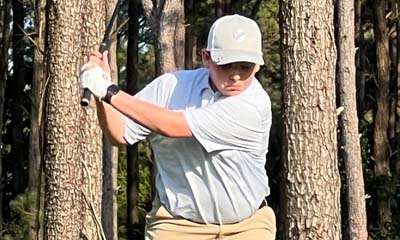Neuroblastoma
Thomas Evans is an avid golfer. He’s played from a young age, both with the PGA Jr. League at his local country club and on his school team. With so much time spent on the course, it was no surprise when he came home after a weekend of golfing complaining about his side hurting. “He had been playing golf all weekend, but it was an unusual complaint, so I went ahead and took him to the pediatrician,” his mother, Julie, explained.
Everything checked out fine, but on a whim, the pediatrician sent Thomas on for an ultrasound. That’s when they found an unexpected mass on his right adrenal gland. “We drove up to Children’s of Alabama the very next day and met with Dr. (Kimberly) Whelan and the oncology team,” his father, Clint, said. “Dr. (Elizabeth) Beierle, who ended up being Thomas’ surgeon, came by as well to talk with us about what it could be and how we moved forward.”
At the time, doctors hypothesized it was pheochromocytoma, a rare but treatable tumor that typically forms in the adrenal gland. Working with that theory, doctors sent Thomas home to begin preparing for surgery, which required taking multiple medications—Thomas was taking 40 or more pills per day—and gaining water weight to protect his heart during the eventual surgery to remove the mass.
After a couple of weeks of preparation, Thomas went in for surgery. It took 10 hours, and the mass turned out to be a 10-pound tumor that was discovered to actually be neuroblastoma. “Most people with neuroblastoma are diagnosed between 18 months and 5 years of age,” Clint explained. “Thomas was 10. The mortality rate for a kid his age with it is high—upwards of 85%—but thankfully he’s done well so far.”
Surgery was successful, but Dr. Whelan recommended that Thomas see Dr. Brian Weiss, a hematologist-oncologist at Cincinnati Children’s Hospital who specializes in treating children Thomas’ age with neuroblastoma. Dr. Weiss found that everything looked good and requested that Thomas return in six months for a follow up. Six months later, a scan showed an abnormal lymph node, and it was evident that Thomas’ neuroblastoma had returned. Thomas began a regimen of both inpatient IV chemotherapy and oral chemotherapy. As he was nearing the end of that treatment plan, Thomas once again began complaining of abdominal pain, and another spot was found near his spine. Collaborating once again with Dr. Weiss in Cincinnati, his care team developed another plan: more intensive IV chemotherapy, surgery, two autologous bone marrow transplants, radiation and immunotherapy.
After four rounds of IV chemotherapy, Thomas had another surgery in which doctors worked to debulk as much of the tumor as possible. He then finished two more rounds of chemo and had back-to-back bone marrow transplants. “He had a month in between each transplant,” Clint added. “We were in the hospital for a month with each transplant, but all of the doctors and nurses, everyone we came in contact with was great. They did their very best to make Thomas and us comfortable.”
Post-transplant, Thomas finished 12 radiation treatments and six rounds of immunotherapy, and since then, he’s had no signs of active cancer. “We go in every three months for testing, and so far, he’s been stable with no change,” Clint added. “While it can’t be said yet that he’s cancer free, no change with each test is the best we can ask for.”
With treatment hopefully behind him, Thomas has gotten back to what he loves: getting out on the golf course. He’s back on his school’s golf team this year and will soon be participating in the Regions Tradition as a patient ambassador for Children’s of Alabama. “We are so thankful for everyone at Children’s,” Julie said. “I just can’t say enough good things about Dr. Whelan, Dr. Beierle and the entire team. We knew we were in such good hands the entire time. They have become like family. The care they took and continue to take with Thomas means the world to us.”











